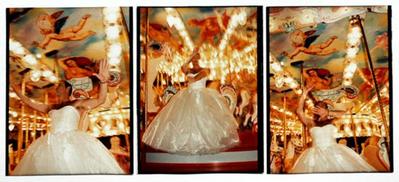unknown (triptych)
Hunter ReynoldsPhotograph
1994 – 1997Ektacolor print
7 x 5 inches each, of three images in triptych
Edition: 1 of 50, Artist's Edition
Description
The artist identifies the authorship of this work: Hunter Renyolds (collaboration with Maxine Henryson).
I-DEA The Goddess Within is an ongoing photographic diary of the street performances of Patina du Prey. Her/his diary is the result of the coilaboration of performance artist, Hunter Reynolds and photographer, and Maxine Henryson. In the collaboration the stereo-typical male and female roles are flipped and the traditional subject object meanings are changed. A transcendent figure wearing a white duel gendered dress, Patina is a metaphor for the I and Dea, the goddess within all of us. The Objective of I-Dea The Godeess Within is to take this Image into public spaces and create an awareness of multiple gender identity as a transformative healing process. From the artist’s site
Maxine Henryson, is an artist photographer, who is interested in sexual identity and gender politics began working with Hunter Reynolds in 1992 when he was performing as his alter ego, Patina du Prey. Reynolds developed the persona in order to confront homophobia in the arts in 1989. He is a visual artist, working with performance, sculpture and photography. Hunter’s gallerist, Mary Goldman, writes of his work: “Patina exists as a mythical figure defined by both male and female signifiers. She deliberately includes Reynolds’s ‘maleness’ with her lack of both false breasts and wigs. Drawing on this disruption of gender icons, Patina relates to his/her audience as a shamanistic, transgendered embodiment of fantasy and healing. Maxine Henryson’s color photographs construct a visual biography comprised of episodes in Patina du Prey’s life. When photographing Patina, Henryson searches out evocative moments; using her camera, she creates true fictions. Cumulatively, these photographs, like memories and dreams, create a non-linear visual narrative. Henryson’s photographic eye, like a satellite, captures the world that comes between her lens and Patina’s flowing white dress. Playing with notions of gender as performance, identity, transformation, healing and the goddess, the artists flip traditional gender roles. Patina, the cross-dressed male performance artist, and the passerby all become subjects of Henryson’s female gaze and the art work as an aleatoric event. Both playful and confrontational the compelling and beautiful images, as seen here in Carousel, Antwerp, challenge us to think of gender roles as inherently multiple and easily susceptible to subversion just as they indicate that the work of art arises from the chance mixture of the artist’s performance and the social landscape in which it takes place.”
